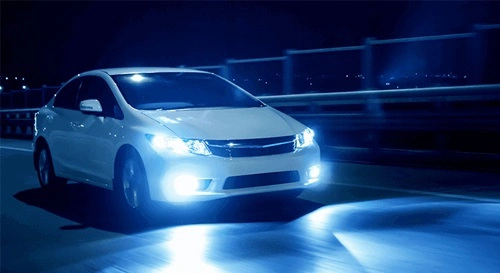Yes, LED headlights are legal in India, provided they comply with the regulations set by the Central Motor Vehicles Rules (CMVR), 1989 and do not cause glare or endanger other road users. However, the legality of aftermarket LED headlights depends on their brightness, beam alignment, and compliance with Indian automotive standards.
Legal Framework Governing LED Headlights in India

The use of LED headlights in vehicles is regulated under the Motor Vehicles Act, 1988, and the Central Motor Vehicles Rules, 1989. Here’s an overview of the rules and their implications:
1. Permissible Use of LED Headlights
- Factory-Fitted LED Headlights:
- Vehicles equipped with LED headlights by the manufacturer are generally compliant with CMVR regulations.
- These headlights are tested and approved to ensure they meet Indian standards for brightness and beam focus.
- Aftermarket LED Headlights:
- Installing aftermarket LED headlights is legal only if:
- The lights do not exceed permissible brightness levels.
- The beam is properly aligned to prevent glare.
- The headlights are certified to comply with CMVR standards.
- Installing aftermarket LED headlights is legal only if:
2. Brightness and Beam Regulations
- Luminous Intensity:
- The brightness of headlights must fall within the limits specified by the Bureau of Indian Standards (BIS).
- Excessively bright headlights can blind oncoming drivers, leading to accidents.
- Beam Alignment:
- The beam must be aligned in such a way that it illuminates the road without causing glare to other drivers or pedestrians.
- Improperly aligned LED headlights are considered a violation of road safety regulations.
3. Colors of LED Headlights
- White and Yellow Lights:
- The CMVR permits the use of white or yellow lights for headlights, as these colors provide optimal visibility without causing significant glare.
- Prohibited Colors:
- Colors like blue, red, green, or any other non-standard colors are not allowed for headlights, as they can confuse other road users and mimic emergency vehicle lights.
Consequences of Using Non-Compliant LED Headlights
- Fines and Penalties:
- Using non-compliant headlights can result in fines under the Motor Vehicles Act, 1988.
- Traffic police may issue challans for illegal modifications or non-compliance with CMVR standards.
- Vehicle Rejection During Inspections:
- Vehicles with unauthorized modifications, including non-compliant LED headlights, may fail inspection tests required for roadworthiness certification.
- Accidents and Liability:
- Drivers using excessively bright or misaligned LED headlights may be held liable for accidents caused by glare or poor visibility.
Steps to Ensure Your LED Headlights Are Legal
- Check Manufacturer Compliance:
- Use LED headlights provided or recommended by the vehicle manufacturer to ensure compliance with CMVR standards.
- Verify Certification:
- Ensure that aftermarket LED headlights are certified by the Bureau of Indian Standards (BIS) or similar authorities.
- Proper Installation:
- Get your headlights installed by a professional to ensure proper alignment and beam focus.
- Avoid Excessively Bright LEDs:
- Do not use LED headlights with excessive luminous intensity, as they can impair visibility for other road users.
Recent Developments and Awareness Campaigns
- Stricter Enforcement:
- Traffic authorities are increasingly monitoring vehicles with aftermarket LED modifications to ensure compliance with safety norms.
- Focus on Glare Reduction:
- The government and automotive associations are raising awareness about the dangers of glare caused by illegal LED modifications.
- Advancements in Headlight Technology:
- Manufacturers are introducing adaptive LED headlights that automatically adjust the beam to reduce glare for oncoming vehicles.
Conclusion
Your car’s LED headlights are legal in India if they comply with the standards set by the Central Motor Vehicles Rules (CMVR), 1989. While factory-fitted LED headlights are usually compliant, aftermarket modifications require careful consideration of brightness, beam alignment, and certification. Ensuring compliance with these rules not only helps you avoid penalties but also contributes to safer roads for all users.
Hina Abbasi is Editor and a passionate sports and entertainment content writer at WinnersMaze.com. Hina’s expertise spans across a wide range of sports, and interest in many TV shows allowing her to deliver insightful analysis and compelling stories that resonate with readers.

